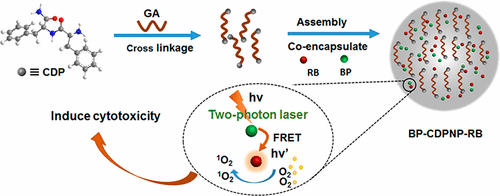当前位置:
X-MOL 学术
›
Biomacromolecules
›
论文详情
Our official English website, www.x-mol.net, welcomes your
feedback! (Note: you will need to create a separate account there.)
Bis(pyrene)-Doped Cationic Dipeptide Nanoparticles for Two-Photon-Activated Photodynamic Therapy
Biomacromolecules ( IF 5.5 ) Pub Date : 2017-08-25 00:00:00 , DOI: 10.1021/acs.biomac.7b00780 Bingbing Sun 1 , Lei Wang 2 , Qi Li 1 , Pingping He 2 , Huiling Liu 2 , Hao Wang 2 , Yang Yang 2 , Junbai Li 1
Biomacromolecules ( IF 5.5 ) Pub Date : 2017-08-25 00:00:00 , DOI: 10.1021/acs.biomac.7b00780 Bingbing Sun 1 , Lei Wang 2 , Qi Li 1 , Pingping He 2 , Huiling Liu 2 , Hao Wang 2 , Yang Yang 2 , Junbai Li 1
Affiliation

|
At present, one of main problems for photodynamic therapy (PDT) is how to improve the treatment depth. Two-photon activated (TPA) developed recently provide a possible solution for it. In this work, we report the energy-transferring assembled cationic dipeptide nanoparticles for two-photon activated photodynamic therapy (TPA-PDT). In the nanoparticles, the coencapsulated two-photon fluorescent dye bis(pyrene) (BP) is an energy donor, and a photosensitizer rose bengal (RB) is an acceptor based on an intraparticle fluorescence resonance energy transfer (FRET) mechanism. BP in the nanoparticles can be excited by one- or two- photon laser. And then, the energy of BP was transferred to RB, which highly enhanced the generation of singlet oxygen. The cellular experiments indicated that this nanosystem can induce the cytotoxicity under one- and two-photon irradiation, which allows further applications of FRET-based biomaterials for TPA-PDT.
中文翻译:

双(py)掺杂的阳离子二肽纳米粒子的双光子激活光动力疗法。
目前,光动力疗法(PDT)的主要问题之一是如何提高治疗深度。最近开发的双光子激活(TPA)为它提供了一种可能的解决方案。在这项工作中,我们报告了能量转移组装的阳离子二肽纳米粒子用于双光子激活的光动力疗法(TPA-PDT)。在纳米粒子中,基于粒子内荧光共振能量转移(FRET)机理,共封装的双光子荧光染料双(py)(BP)是能量供体,光敏剂玫瑰孟加拉(RB)是受体。纳米粒子中的BP可以被一或两个光子激光激发。然后,BP的能量转移到RB,这大大提高了单线态氧的生成。
更新日期:2017-08-25
中文翻译:

双(py)掺杂的阳离子二肽纳米粒子的双光子激活光动力疗法。
目前,光动力疗法(PDT)的主要问题之一是如何提高治疗深度。最近开发的双光子激活(TPA)为它提供了一种可能的解决方案。在这项工作中,我们报告了能量转移组装的阳离子二肽纳米粒子用于双光子激活的光动力疗法(TPA-PDT)。在纳米粒子中,基于粒子内荧光共振能量转移(FRET)机理,共封装的双光子荧光染料双(py)(BP)是能量供体,光敏剂玫瑰孟加拉(RB)是受体。纳米粒子中的BP可以被一或两个光子激光激发。然后,BP的能量转移到RB,这大大提高了单线态氧的生成。











































 京公网安备 11010802027423号
京公网安备 11010802027423号